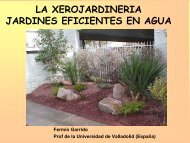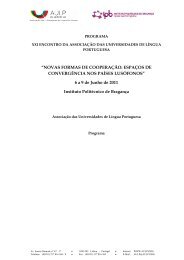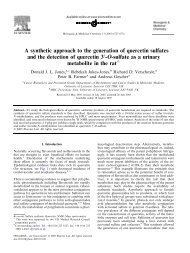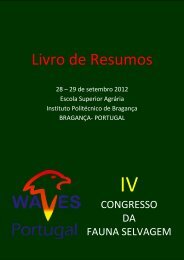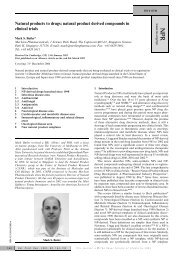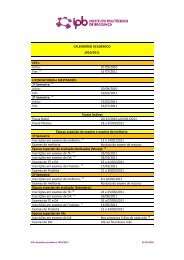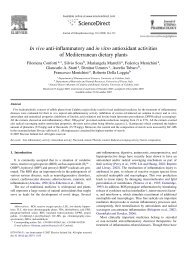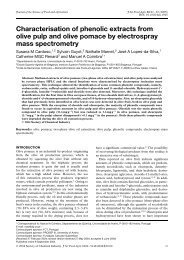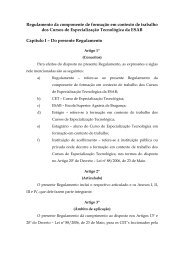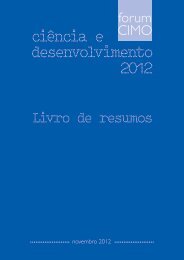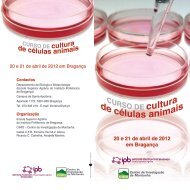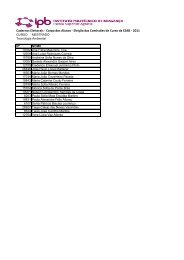Silva et al 2012 Atas Portuguesas de Horticultura - ESA - Escola ...
Silva et al 2012 Atas Portuguesas de Horticultura - ESA - Escola ...
Silva et al 2012 Atas Portuguesas de Horticultura - ESA - Escola ...
You also want an ePaper? Increase the reach of your titles
YUMPU automatically turns print PDFs into web optimized ePapers that Google loves.
VI Simpósio Nacion<strong>al</strong> <strong>de</strong> Olivicultura, Miran<strong>de</strong>la, 15 a 17 <strong>de</strong> novembro <strong>de</strong> <strong>2012</strong><br />
associated with the soil of olive groves and to ev<strong>al</strong>uate the effect of crop<br />
intensification on this community.<br />
Spi<strong>de</strong>rs were sampled monthly during 2010 in four olive groves in the region of<br />
Serpa (Alentejo, Portug<strong>al</strong>). Pitf<strong>al</strong>l traps were placed in the soil for a period of 24 hours,<br />
next to the trunk of 25 randomly selected trees, for an inventory of spi<strong>de</strong>rs in the<br />
soil.The arthropods were taken to the laboratory, sorted and i<strong>de</strong>ntified. In case of the<br />
spi<strong>de</strong>rs they were even i<strong>de</strong>ntified to the family using keys of i<strong>de</strong>ntification. For data<br />
an<strong>al</strong>ysis, a multivariate an<strong>al</strong>ysis (PCA) was applied and Estimates software was used to<br />
c<strong>al</strong>culate family accumulation curves.<br />
A tot<strong>al</strong> of 175 samples were collected and 23 families were i<strong>de</strong>ntified. Of these,<br />
the most abundant were Agelenidae and Lycosidae in tradition<strong>al</strong> olive groves,<br />
Linyphiidae and Agelenidae in intensive olive groves, and Lycosidae and Gnaphosidae<br />
in organic olive groves and fin<strong>al</strong>ly, Titanoecidae and Agelenidae in the hedgerow olive<br />
groves.<br />
Keywords: Olea europaea, spi<strong>de</strong>rs, pitf<strong>al</strong>l, cultur<strong>al</strong> practices, biodiversity.<br />
Introdução<br />
Nos últimos 40 anos, nos países mais <strong>de</strong>senvolvidos tem-se experimentado<br />
uma revolução agrícola. O impacto <strong>de</strong>ssa transformação foi t<strong>al</strong> que as priorida<strong>de</strong>s da<br />
socieda<strong>de</strong> para a agricultura e uso da terra mudaram substanci<strong>al</strong>mente (Lafferty &<br />
W<strong>al</strong>sh, 1999). Estas mudanças dramáticas no uso do solo incluem a conversão <strong>de</strong><br />
ecossistemas naturais complexos para ecossistemas simplificados e geríveis na<br />
intensificação da utilização <strong>de</strong> recursos, incluindo a aplicação <strong>de</strong> pesticidas. Não só a<br />
biodiversida<strong>de</strong> <strong>de</strong> habitats naturais e tradicionais <strong>de</strong> baixa intensida<strong>de</strong> nos agroecossistemas,<br />
mas também a biodiversida<strong>de</strong> <strong>de</strong> agro-ecossistemas intensamente<br />
utilizados tem sido muito reduzida nas últimas décadas (Tscharntke <strong>et</strong> <strong>al</strong>., 2005).<br />
Nos agro-ecossistemas, as aranhas fazem parte <strong>de</strong> comunida<strong>de</strong>s ricas em<br />
espécies herbívoras, d<strong>et</strong>ritívoras e carnívoras. O efeito <strong>de</strong> uma espécie <strong>de</strong> Aranea<br />
numa população <strong>de</strong> uma praga po<strong>de</strong> ser rapidamente aumentado, se a população <strong>de</strong><br />
Aranea aumentar rapidamente em resposta a um aumento <strong>de</strong> presas <strong>al</strong>ternativas<br />
(Jeffries & Lawton,1984; Axelsen <strong>et</strong>. <strong>al</strong>., 1997 cit in Sun<strong>de</strong>rland 1999).<br />
Segundo Yardim & Edwars (1998), as aranhas ten<strong>de</strong>m a ser <strong>al</strong>tamente sensíveis<br />
a pesticidas não-específicos, tais como o dim<strong>et</strong>oato ou <strong>de</strong>ltam<strong>et</strong>rina. Além disso, estes<br />
tratamentos têm um efeito indirecto negativo sobre as aranhas através da redução do<br />
número <strong>de</strong> presas <strong>de</strong> artrópo<strong>de</strong>s (Bogya & Marko, 1999). As diferentes famílias <strong>de</strong><br />
aranhas parecem ser afectadas <strong>de</strong> maneiras diferentes por estes tratamentos. Por<br />
exemplo, as aranhas construtoras <strong>de</strong> teias, parecem ser menos afectadas pelos<br />
produtos químicos, do que as aranhas que caçam as suas presas no solo (Mark <strong>et</strong> <strong>al</strong>.,<br />
1999). Além disso, as aranhas construtoras <strong>de</strong> teias complexas apresentam melhor<br />
resistência aos pesticidas (Pekár, 1999).<br />
O princip<strong>al</strong> objectivo <strong>de</strong>ste trab<strong>al</strong>ho é contribuir para conhecer o impacto <strong>de</strong><br />
diferentes sistemas <strong>de</strong> condução do oliv<strong>al</strong> sobre a abundância e diversida<strong>de</strong> das<br />
comunida<strong>de</strong>s <strong>de</strong> aranhas do solo.<br />
<strong>Atas</strong> <strong>Portuguesas</strong> <strong>de</strong> <strong>Horticultura</strong>, n. o 21 (<strong>2012</strong>) 282



